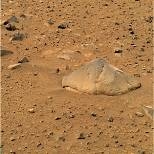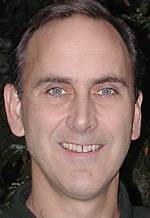A geologist's concept of time is slow, layered and measured in tens of thousands of years, but geologist John Grotzinger is growing accustomed to a new measurement -- sols.
He traveled 3,000 miles by airplane to work 12-hour days on Mars. Now he's got 90 days to figure out what might have happened 3 million years ago on a planet 48.6 million miles away from Earth.
Sound a little like Indiana Jones meets Captain Jean-Luc Picard? Well, it is. Only this Indiana Jones lives in a house in Pasadena, Calif., and drives to NASA's Jet Propulsion Lab to work each sol (martian day).
Grotzinger, a professor in MIT's Department of Earth, Atmospheric and Planetary Sciences whose specialty is sedimentology, is leader of the long-term planning group of NASA's science team overseeing the work of the Mars rover Spirit, which landed on Jan. 3.
His day starts when Spirit's does. A Mars sol is about 39 minutes longer than an Earth day, which means Grotzinger's 12-hour work cycle shifts forward by 39 minutes each day.
"Right now I'm in phase with the world in California," said Grotzinger in a telephone interview. "The first three weeks were not so easy. I was going to work at 10 o'clock at night and coming out at 10 o'clock in the morning. Then I'd eat breakfast and go to bed at noon. That schedule advances 39 minutes every day."
Grotzinger's job as group leader is to plot strategy so the science team accomplishes as much as it can "within the 90-sol mission," he said.
"I have to prevent day-to-day curiosity from interfering with the set of long-term scientific objectives," he said. "For instance, we might have the desire to analyze several different rocks around the rover. Say we go to Adirondack [the first rock that Spirit visited] and analyze it. You can pose the hypothesis that the rock next to Adirondack might be different because it looks different. If you were to analyze it, that would take three to four days, and that might detract from achieving a longer-term goal. You have to weigh the tradeoffs of short- versus long-term objectives.
"Investing a lot of time in certain rocks may not lead to an understanding of water. So in leading that group, I'm constantly making sure that there aren't things off in the distance we can see that we should target to get information on the water issue."
What he hopes to find is rock that contains a mineral that might have formed in water, or evidence that the terrain might have been influenced by water flowing over or around it. And that requires the rover to drive some distance to give the scientists a good look. "The way boulders get piled up by water is a morphological feature you can only appreciate after you drive over the terrain," he explained.
Grotzinger calls himself a "neophyte" when it comes to working with an engineering team. "You learn to pose a hypothesis within the constraints of the project," he said. "I can't walk into the crater and bash off a piece of rock with my hammer."
Instead, the engineers hope to use the rover's rock abrasion tool to grind down the weathered rock and take an image from inside. "In order to really enjoy this you have to have a lot of heartfelt faith in the procedures and in what the engineers can accomplish," he said.
Grotzinger and a few other scientists are also serving as guinea pigs of a sort. NASA is interested in how their sleep patterns are affected by the sol schedule. He wears a bracelet-like "accelerometer" around his wrist so that NASA can keep track of the hours his body is motionless, as in deep sleep.
Participating scientists keep a diary, but aren't always aware when they're sleeping and when they're tossing and turning.
But the real mission goals are the big ones -- learning more about the origin of life and the evolution of life on Earth.
"Is the evolution of life on Earth unique? The best place to answer that question is on Mars," said Grotzinger.
"There is no doubt in my mind that there was water on Mars. The question is: Did this water hang around long enough to allow life to develop like it did on Earth? If not, there's still the question of a groundwater system that could have porous rocks that could tell us about the origin of life.
"These missions are absolutely essential to test these hypotheses."
Grotzinger's daughters have their own questions. His family visited him last week to watch Opportunity land on the opposite side of Mars. His nine-year-old daughter, Hannah, asked why everything is red and why the people in the control room were excited to hear a "beep" from the rover. On the other hand, his six-year-old, Heather, watched a while before posing her own question: "So Dad, have you found any Martians yet?"
A version of this article appeared in MIT Tech Talk on January 28, 2004.







